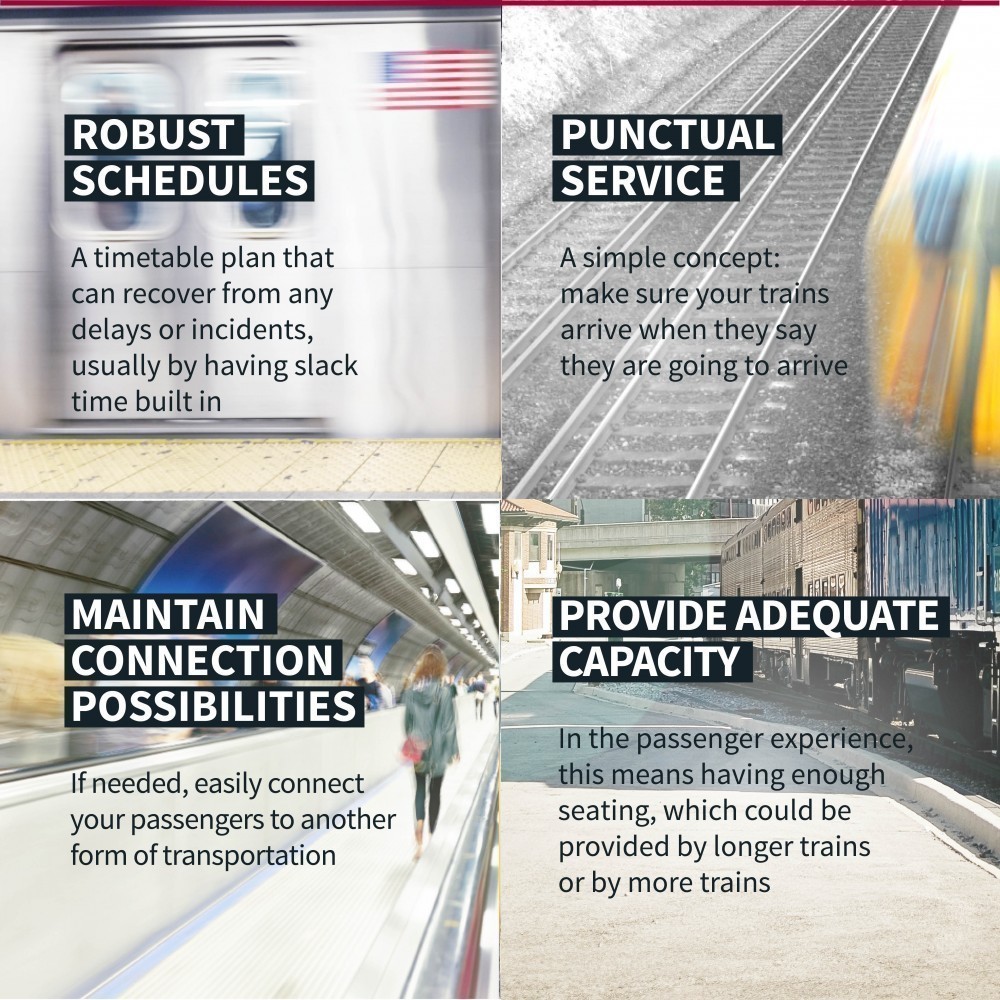Hear the clicks and the clacks of that old-school flip board telling you the schedules of the next train. They come fast and furious with each new train that departs or arrives. Even with its nostalgia, it still has a function – to let you know where your train is located (track number) and when it is set to depart.
But, what happens when a train has an issue and can’t leave right away or breaks down and the replacement train goes to a different track? You hear constant clicks and clacks as the board updates and you wait to see your new track/train location or new departure time. And if it isn’t updating properly, the clicking and clacking begins to annoy you as you become frustrated with the delay or nervous you might miss your train.

Now, this isn’t anything against flip boards because I actually love their classic allure. And this isn’t about switching to a digital board. It’s all about the complexities of rail scheduling and how it relates to your passengers’ experience.
Passenger Experience – Beating a Dead Horse
The headline above isn’t just trying to get your attention, it’s something that always needs to be addressed. And the more it gets talked about, the more you might think you are getting beat over the head with passenger experience. But why is it so important? Why is it you should be thinking about your passengers’ experience on-board one of your trains?
If it wasn’t for them, you wouldn’t have a railroad to worry about. More people would have to drive causing even more traffic – which we all know there is already enough of. It could compound our commute times and make it more difficult for those who maybe can’t afford a vehicle.
You have the ability to provide an alternative to passengers that need it. It doesn’t matter if it is because they can’t afford a vehicle and have to take a train or if your passenger is environmentally conscious and is trying to cut down on the emissions of single occupant vehicles. Whatever the reason your passengers are on board, they and their experience needs to be at the forefront of your thoughts.
This, no matter what, will never change. In order to achieve and provide excellent customer experiences railroads must focus on:

Planning and Operations
What are some complexities of keeping the railway schedule running? For example, there are difficulties dealing with bottleneck issues because of running on single track. So, if the track has inefficiencies in it (like not having sidings at regular intervals), that’s an issue that is out of your control, but you still need the best solution to counteract this challenge.
Many commuter lines are shared with freight which creates another challenge: Right of way management. Your timetable needs to be flexible enough to incorporate a potential delay due to giving the go-ahead to a freight train.
These are just a couple examples of the intricacies of rail scheduling. Remember, all of these issues relate back to giving passengers what they want – great customer experience by getting them where they want, at a time that is convenient for them.
Different Nature, Different Beast
The above examples start to paint the picture of rail scheduling’s own unique challenges. So far, the discussion has been all about what you need to worry about regarding your passenger’s experience. But what can you actually do to help achieve these goals? What are some of the things within your control that will actively correlate to your passengers experiencing high-end satisfaction?
Optimization
This could be the same as minimizing resources, but could also mean altering the timetable to optimize the service. For example, a change to the timetable might reduce the total resource requirements because no additional rolling stock and/or crew may be needed. This impacts the robustness of the plan and therefore the passenger experience.
Incident Management
Giving controllers visibility of all proper data to react positively to incidents (train broken down, crew illness, etc.). Again, this relays back to the robustness and punctuality of your schedule/services by providing exemplary passenger experience as you are still able to get passengers to their destinations on time.
Decision Support
When a controller tries to resolve a problem, the system suggests solutions and shows their ramifications on the whole plan. Relating to incident management, these are best summarized as getting back to the plan as quickly as possible. Therefore reducing additional costs through additional resources and minimizing any inconvenience to the passenger.
Minimize Resource Utilization
Creating an efficient plan to provide the required service using the least number of rolling stock and crew. This means that you are understanding your passengers and their travel patterns properly. If you are able to reduce the number of resources used and still provide your passengers with efficient service, then you know you are onto something. Reducing your active resources saves you money. So, with the profitability factor coming into play, it would help to know where to reinvest the money being saved back into other services that might make your passengers happy.
Backwards Forwards (Planning for a Specific Outcome)
Focusing on the outcome before the solution might feel strange, but it will help you make the decisions on how to best serve your passengers. Furthermore, this will eventually play into the larger factor of how to plan your short-term and long-term operations to maximize customer satisfaction.

And just like your passengers that are constantly looking up at that flip board, trying to determine how they are going to get to their destination, you have to look at your agency’s destination. You need to figure out where you want to go and only then will you be able to figure out how you are going to get there. If you aren’t worried about missing your metaphorical train due to scheduling complications, your passengers won’t be stressed about missing their real train because you’ve already got them covered.
Want to learn more? Check out this e-book about some of the other major challenges facing commuter rail.
Marcelo Bravo has dedicated his entire career to rail and transit with over 25 years of experience in the industry. Previous responsibilities have included the delivery of passenger rail cars from cradle to grave, Enterprise Asset Management (EAM) software, and management consulting to transit authorities and railroads, in both North America and abroad. As the Industry Solutions Manager for Rail, Marcelo is in charge of the rail market strategy for North America, which encompasses the Trapeze Rail Enterprise range of offerings.
 Bus
Bus Rail
Rail Paratransit
Paratransit





